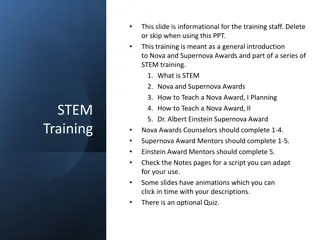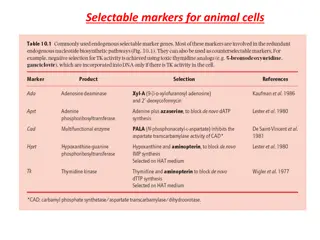Impact of Implementing Learning Design Approaches in STEM over 4 Years
Evaluating the impact of implementing learning design approaches in STEM from July 2017 to July 2021, focusing on practices, products, and processes. The study explores the Open University Learning Design Initiative, principles of learning design, and research questions related to the impact on module teams, collaborative work, learning designs, and approval processes in STEM.
Download Presentation

Please find below an Image/Link to download the presentation.
The content on the website is provided AS IS for your information and personal use only. It may not be sold, licensed, or shared on other websites without obtaining consent from the author.If you encounter any issues during the download, it is possible that the publisher has removed the file from their server.
You are allowed to download the files provided on this website for personal or commercial use, subject to the condition that they are used lawfully. All files are the property of their respective owners.
The content on the website is provided AS IS for your information and personal use only. It may not be sold, licensed, or shared on other websites without obtaining consent from the author.
E N D
Presentation Transcript
Evaluating the Impact of Implementing Learning Design Approaches in STEM over 4 Years (July 2017 July 2021) Tom Olney Senior Manager, Learning & Teaching STEM Deanery Carlton Wood Senior Lecturer EEES
What does it mean to do learning design in STEM?
Learning Design as practice, product and/or process Practice: The action of applying Learning Design concepts to the creation and implementation of a piece of teaching and learning. Product: A learning design a plan or recorded sequence of teaching and learning activities Process: One or more events or stages that are attended or completed to assist in the development of a piece of teaching and learning When someone says, Learning Design , which of these do you think of first? 3
Open University Learning Design Initiative (OULDI) - timeline Part of the Institutional Approaches to Curriculum Design and Delivery programme which was co- funded by the Joint Information Systems Committee (JISC) and the European Union (EU). The OULDI pilot conducted interviews across university to capture module design practice (2007- 2012). Findings led to recommendations and changes to processes for module production. Recommendations piloted by the Learning Design Project team in Institute of Educational Technology (IET) working with all faculties (2013-2015). Science faculty and Maths, Computing & Technology (MCT) faculties - existing practice. Creation of STEM and creation of Learning Design team in LDS (2016). Four new faculties: (STEM, WELs, FASS, FBL) + LDS-LD have evolved different approaches over the way they interpret and embed these principles into the faculty structures, governance and procedures designed to support module teams. (2016-present) 4
What does it mean to do Learning Design at the OU? Principles of 1. Mechanisms to encourage design conversations across disciplines and expert roles 2. The use of tools and instruments as a means of describing and sharing designs 3. The use of information and data to inform the conceptual tools and frameworks that guide the decision-making process 5
Research Questions RQ1: How has STEM learning design impacted on module teams design practice, their collaborative ways of working and their perceptions of effectiveness? RQ2: How has STEM learning design impacted the intended learning designs that are produced? RQ3: How has STEM learning design impacted on internal STEM module approval processes? RQ4: What arrangements enable and constrain the enactment of learning design practice in STEM? 7
RQ1: learning design as practice 1. The MTC Induction meeting with the AD-Student Experience and Head of Curriculum, Strategy and Governance prepared me for my role and responsibilities during production. 2. The STEM MTC Induction Guidance (Production) website (https://learn3.open.ac.uk/course/view.php?id=300862) assisted me in preparing for production and, when referred to, contained the information I needed to know. 3. The agenda for the Learning Design Workshop provided an outline that met both the specific needs of the module team and also enabled participants to focus on the student experience. 4. The Learning Design workshop was useful as an opportunity to be more effective and more collaborative in the process of designing a student focused module. 5. The Learning Design workshop was useful as an opportunity to be more effective and more collaborative in the process of preparing the module specification (REP03) documentation for submission. 6. Visualizing the proposed module using the Activity Planner was useful as a way to be more effective and more collaborative in the process of designing a student focused module. 7. The visualization generated using the Activity Planner that was submitted with the REP03 will accurately reflect the student experience in the final module design. 8. General comments 8
RQ1: learning design as practice Level of agreement with 'components of STEM learning design' statements over time between LDW and SG for CM Level of agreement with 'components of STEM learning design' statements over time between LDW and SG for MTC 21 Level of agreement 18 15 12 21 9 18 Level of agreement 6 15 3 12 0 0 5 10 15 20 9 Time between LDW and SG Approval (months) 6 3 0 0 5 10 15 20 Time between LDW and SG Approval (months) 10
RQ2: learning design as product Learning Design Intention Comparison between Modules 100 90 Distribution of activity types (%) Learning Design Intention Comparison with OU 80 42.2 45 70 39.2 Mean average distribution (%) 40 60 35 28.6 50 30 40 25 30 17.3 20 14.9 20 15 11.0 9.9 7.8 7.5 7.4 10 10 4.5 4.1 3.8 1.9 5 0 A C D G F M Modules (in order of module specification approval) J L N O H R T U Y X Z BB AA S 0 Assimilative F&H Communication Productive Experiential Interactive Assessment Activity Type OU mean average 2015 (%) STEM mean average 2017-2021 (%) 11
RQ3: learning design as process 14 interviews with Board of Studies (Academic 2, Professional 3) or Scrutiny Group (Academic 4, Professional 5) members past and present. 9 had attended LDW. Focus on changes in quality of module specifications, confidence in MTs readiness for production, and efficiency of process over time from learning design activity. Difficulties articulating a direct link between LD support and change in these areas. Memory issues! Experience of MT a substantial contributing factor to all three areas. Perception of change to quality of spec: quality declined = 0, no change to quality = 9 quality improved = 5. Perception of change in confidence that MTs ready for production: less confident =3*, no change = 5, more confident = 6 Perception of change to efficiency of process: less efficient = 0, no change = 9, improved = 3, declined = 2 Lots of very positive comments centred on ringfencing/protecting time to focus on student experience (learning outcomes/student workload) over content. Removal of blankcheque . Some negative perceptions focused on LD as hurdle , step in process/tick box exercise 12
RQ4: the arrangements that enable and constrain practice 13
Recommendations 1. Time - optimum time between LDW and SG approval 2-5 months 2. Contextualisation concentrate on the adaptability of LD for different contexts 3. Experience mechanism for sharing experiences 4. Re-orientation of LD away from an association with process, towards an association with practice and/or product 14
Discussion: How should Learning Design be supported in STEM? What are your experiences of LD at the OU or elsewhere? What are your thoughts? What types of support would you like to see developed? What kinds of evaluation/research projects would you like to see?
References Conole G. (2013) Designing for Learning in an Open World.Explorations in the Learning Sciences, Instructional Systems and Performance Technologies, vol. 4: New York: Springer. Dagnino F, Dimitriadis Y, Pozzi F, Asensio-P rez J & Rubia-Avi B (2018) Exploring teachers needs and the existing barriers to the adoption of Learning Design methods and tools: A literature survey British Journal of Educational Technology Vol 49 No 6 2018 998 1013 http://dx.doi:10.1111/bjet.12695 Dalziel, J., Conole, G., Wills, S., Walker, S., Bennett, S., Dobozy, E., Cameron, L.,Badilescu-Buga, E., & Bower, M. (2016). The Larnaca Declaration on Learning Design. Journal of Interactive Media in Education. 7, pp.1-24, doi.org/10.5334/jime.407 Galley R (2015) Learning Design at the Open University: introducing methods for enhancing curriculum innovation and quality. Quality Enhancement Report (1) The Open University Kantirou M (2016) A learning design approach for MCT. OU Internal report (https://learn3.open.ac.uk/pluginfile.php/148524/mod_resource/content/2/LD_in_MCT_Aug2016.pdf retrieved 27/02/20) Godsk, M (2017) Improving STEM Undergraduate Education with Efficient Learning Design. EdD thesis. The Open University. Rienties B & Toetenel L (2016) The impact of learning design on student behaviour, satisfaction and performance: A cross-institutional comparison across 151 modules. Computers in Human Behavior. 60: pp.333-341 https://doi.org/10.1016/j.chb.2016.02.074 Mahon K., Kemmis S., Francisco S., Lloyd A. (2017) Introduction: Practice Theory and the Theory of Practice Architectures. In: Mahon K., Francisco S., Kemmis S. (eds) Exploring Education and Professional Practice. Springer, Singapore. https://doi.org/10.1007/978-981-10-2219-7_1 16























